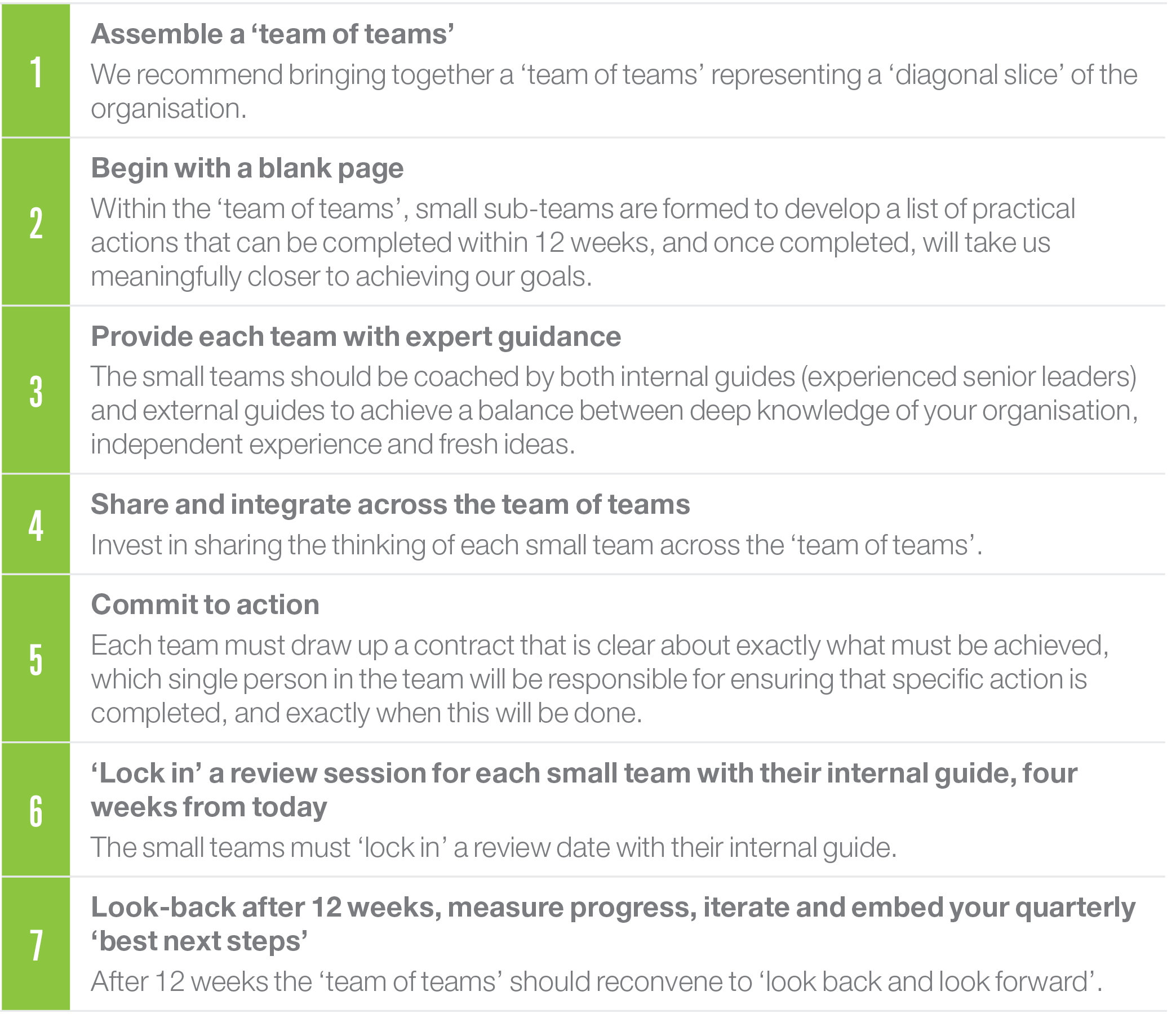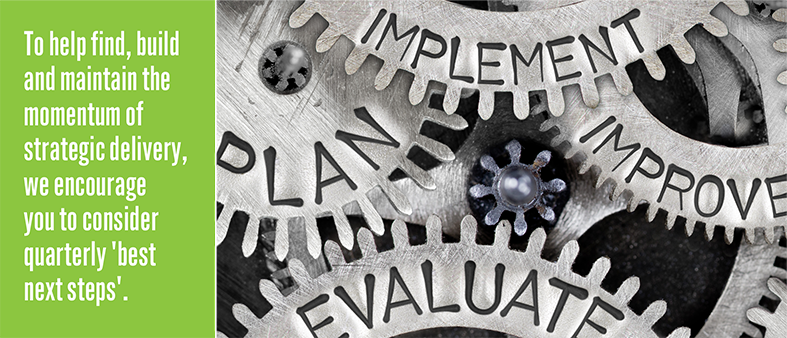Build and maintain the momentum of strategy execution with quarterly ‘best next steps’
by Matt Hardy & Dr James Mills
Too often we see strategies with a long list of actions. The fear for potentially taking the wrong action grips, overtaking the fear of taking no action at all. To overcome this, we urge organisations to develop and embed internal processes to help define their best next steps.
Right Thinking
Finding, building and maintaining momentum for strategic change is a common challenge once the euphoria of strategy development meets the reality of business as usual. Right Lane’s engaging quarterly ‘best next steps’ methodology is designed to re-charge the enthusiasm and momentum built in the strategic planning process. This happens by helping leaders empower and engage small teams to develop and commit to the next best actions to bridge the gap between the new goal and today’s reality.
 You’ve recently been through an engaging, collaborative and inclusive strategy development process; it may even have been facilitated by Right Lane! You’ve articulated a long-term vision of the future. You identified two to four critical goals for your organisation to achieve, some key initiatives to help you reach them, and you agreed how you would track your progress. Everybody was onboard and couldn’t wait to put the new strategic plan in to action. Then they got back to the office.
You’ve recently been through an engaging, collaborative and inclusive strategy development process; it may even have been facilitated by Right Lane! You’ve articulated a long-term vision of the future. You identified two to four critical goals for your organisation to achieve, some key initiatives to help you reach them, and you agreed how you would track your progress. Everybody was onboard and couldn’t wait to put the new strategic plan in to action. Then they got back to the office.
It’s not unusual for teams and organisations to encounter headwinds once they are a few months into strategy execution. As the initiatives kick off, the demands of business as usual set in. The arguments that established such a compelling sense of urgency are now less vividly recalled. Perhaps the market has moved. Perhaps there are burning issues to be dealt with, and the strategic arguments seem less relevant. Immediately after the planning process, there was terrific clarity regarding the organisation’s current position and a clear set of next steps. However, inevitably, this clarity has eroded over time. It is at this point that leaders often find themselves wondering ‘Where are we now?’ and ‘How do we get our momentum back?’.
Our approach to helping leaders answer these questions is inspired by two recent trends we have observed among our clients. The first is that, increasingly, we find clients are turning to project teams to get things done (Levy 2018). With this in mind, our ‘best next steps’ approach leverages the work of General Stanley McCrystal who describes how the United States Army, a rigidly hierarchical organisation, successfully built agility into its operations via a ‘team of teams’ (McCrystal 2015). The key concept, which we believe is equally relevant for non-military organisations, involves fostering agility through small empowered teams, while capturing the advantages of broad consultation through a strict adherence to centralised communication forums.
Another trend we’ve observed is that more clients are embracing a quarterly planning cadence to enhance their strategic focus. For example, recently we heard one CEO tell their leadership team, ‘Everything we do over the next 12 weeks must be about commercialising these new products’. The advantages of quarterly planning sessions have also been espoused by leading management thinkers. For example, David Maister championed this approach in his book ‘Managing the Professional Service Firm’ (Maister 1993).
To help find, build and maintain the momentum of strategic delivery, we encourage you to take these seven ‘best next steps’ on a quarterly basis.

1. Assemble a ‘team of teams’ for a two-day session
The strategic planning process has provided the organisation with clear guidance on what needs to be achieved over the planning period. The challenge now is to match practical action and delivery to these goals, and to be clear about precisely what should be done next.
In our experience, those in the flow of day to day activities typically have valuable insight into the practical actions that are likely to yield the greatest improvement. We therefore recommend bringing together a ‘diagonal slice’ of the organisation. This ‘team of teams’ should be divided into small sub-teams, each including people covering a representative mix of functions and levels.
Let’s say, for the sake of illustration, that you have gathered 25 people from across the organisation for a two-day working session and you have formed them into five small teams of five people each. Get them all together to share a common understanding of what the goals are, where we are today, what’s in store for them in this session, and what we expect of each other. It is crucial to build trust quickly in the ‘team of teams’, as well as in the small teams, so don’t under-invest in context, purpose and team building.
2. Begin with a blank page
Each small team is given three blank pages, having one of the strategic goals at the top (drawn straight from the ‘strategy on a page’ developed in the annual strategic process…there may have been two goals or four goals rather than three – take one page per goal). The five teams are then challenged to develop a list of practical actions that can be completed within 12 weeks, and once completed, will take us meaningfully closer to achieving our goals. The teams should consider but not be anchored to the annual plan – that is, they absolutely will bring the existing plan of initiatives into consideration but their key focus on the blank sheet is developing the next best actions to achieve the strategic goal…whether those actions are related to the strategic initiatives or not.
When the teams do consider the existing strategic initiatives typically they will find that it will not be possible to accomplish an entire strategic initiative within twelve weeks, so teams should ask; ‘What are the necessary actions that must be taken in order to best progress this initiative?’. Repeatedly asking this question will eventually produce actions that are achievable within the twelve-week timeframe.
The actions of the teams must satisfy three criteria. Firstly, they must be actions not targets. For example, ‘Increase website sales’ is a target, whereas, ‘Update the website each week with the current special offers (rather than each month)’ is an action. Secondly, the actions must be achievable within a twelve week period. Third, the actions must constitute a meaningful step towards achieving the strategic goal at the top of the page.
3. Provide each small team with expert guidance
The teams will require guides to help them develop the ‘best next step’ actions that will take us closer to achieving each strategic goal. We recommend including both internal guides (experienced senior leaders) and external guides in this process, as this provides a balance between deep knowledge of your organisation, independent experience and fresh ideas.
We suggest that each team be assigned one internal guide, an experienced senior manager. The role of this guide is to share common context, build trust, empower and help support the team to develop effective actions considering the three criteria outlined above. Given their expert knowledge of the business, these guides are ideally positioned to push teams to be more ambitious when suggested actions are lacklustre, or to provide a reality check if overenthusiasm leads to unrealistic suggestions. It is crucial that the tone of the guide is that of ‘coach and empower’ rather than ‘command and control’, ‘guide’ rather than ‘direct, ‘ask’ rather
than ‘tell’.
The role of the external guides is to move between the groups, clarify and support the process, ask the outside-in ‘what-if’ questions, and help encourage realistic ambition. If the team is struggling, the external guides are well placed to assist with ideation, without undermining the ‘grass roots’ nature of the process.
4. Share and integrate across the ‘team of teams’
Now is the time to invest in sharing the thinking of each small team across the ‘team of teams’. Seek first to understand and clarify, before considering issues of integration and potential duplication. When this collaboration works well, the whole group will help to build on the ideas and thinking that each small team has developed.
5. Commit to action
Next, each team must digest the feedback and commit to action. The teams are empowered to develop actions that will deliver meaningful progress towards the strategic objective and are feasible to complete within the twelve-week timeframe. The internal guides are there to help support the team in their thinking and to help them navigate the challenges of resource requirements. It is crucial that the team is clear about exactly what must be achieved, which single person in the team will be responsible for ensuring that specific action is completed, and exactly when this will be done (precisely twelve weeks from the date of this discussion). This should be recorded on the action page, which then becomes a contract between the person who is ‘on the hook’ for completing the work, and the rest of the team and their internal guide, who are all invested in the team’s success.
6. Lock in a review session for each small team with their internal guide, four weeks from today
At the end of the working session the small teams must ‘lock in’ a review date with their internal guide. The importance of following up with this review cannot be overstated. Failure to do so will create the impression that these actions are not important to senior management.
7. Look-back after 12 weeks, measure progress, iterate and embed your quarterly ‘best next steps’
The final step is to get together after 12 weeks to ‘look back and look forward’. It starts with looking back to assess and review progress of the committed actions, to understand impact, draw out insights, identify learnings and iterate the process. Then the teams would repeat the quarterly ‘best next steps’ cycle (building in any improvements from the identified learnings) and start again with the blank page for the next twelve weeks…now armed with further insight and a ‘backlog’ of ideas and actions.
To fully embed the quarterly ‘best next steps’ methodology it is important that the wider organisation understands what’s happening, that the agreed actions are front of mind, that people understand how the actions developed by the small teams relate to their own work, and how, if at all, they contribute to these actions. This can only be achieved through regular inclusive communication from senior leaders – the internal guides – and from the teams. Typically this includes a ‘before and after’ town hall type get-together.
***
Our ‘best next steps’ methodology is an adaptive, agile process that helps organisations to maintain the momentum and enthusiasm required to deliver the organisations strategic plan. Like Roman armies that laid down roads as they marched, this approach allows leaders to continually identify the direction of greatest benefit and to pave a straight path towards achieving the organisation’s strategic goals.
References
Levy, M 2018, ‘Scaffold strategic projects: giving them the help and support they need’, Right Lane Review, July
McCrystal, S 2018, ‘Team of Teams’, Penguin Publishing Group, New York
Maister, D 2013, ‘Managing the professional services firm’, Maxwell Macmillan International, New York
© 2018 Right Lane Consulting
We hope the ideas presented here have given you something new to think about. We would love the opportunity to discuss them with you in more detail. Get in touch today.

